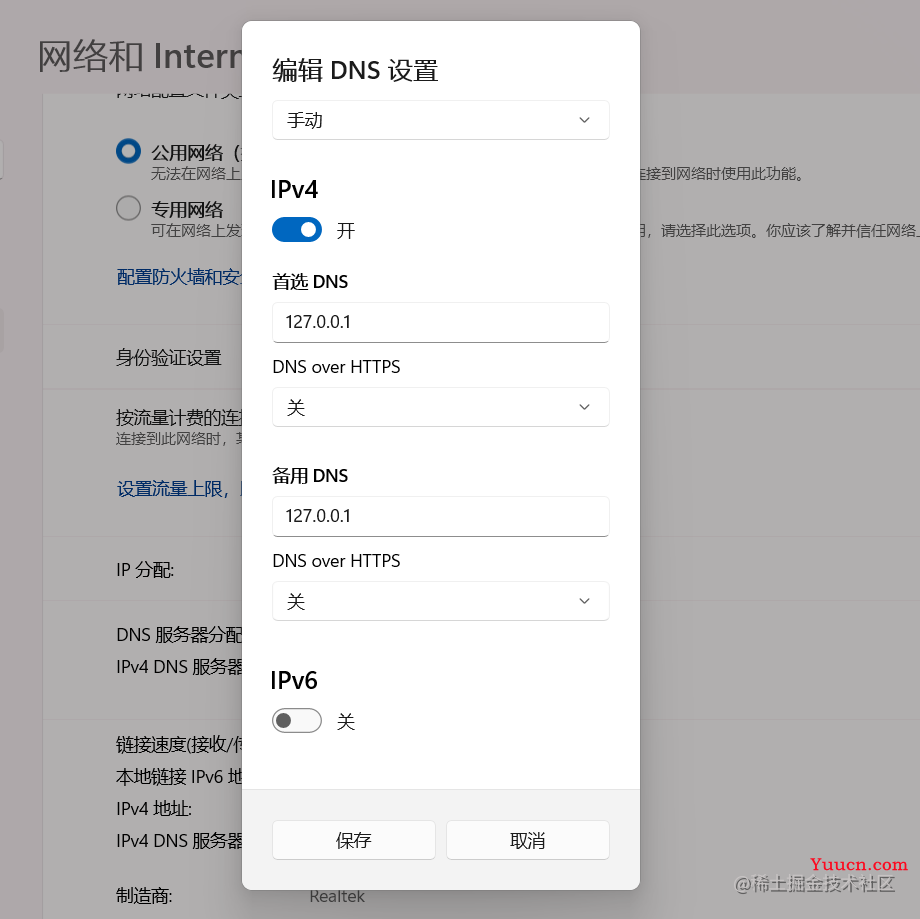前言
DNS协议作为着互联网客户端-服务器通信模式得第一关,在当下每天都有成千上亿上网记录产生得当今社会,其重要性自然不可言喻。在国内比较有名得DNS服务器有电信得114.114.114.114、阿里云得223.5.5.5,DNSPod得119.29.29.29,配置一个好的DNS服务器可以缩短请求响应时间、降低DNS劫持概率,提升上网体验。
上面这些都是互联网公用DNS服务器,本文博主教大家使用 Java Netty 自建DNS代理服务器,目前网上对于使用Netty自建DNS服务器得教程良莠不齐,大多没有代理步骤,达不到博主想要得代理效果,因而创建此文。觉得本文有帮助得可以关注博主github
- https://github.com/wayn111
一、自建DNS代理服务器有哪些优势
- 域名控制:对于特定域名可以自由控制访问权限(屏蔽对特定网站访问)
- 域名记录:记录局域网内各个主机得域名访问(记录员工上网记录)
- 配置内网域名:通过自建DNS服务器可以配置内网域名,节约成本
- DNS负载均衡:通过自建DNS服务器可以轻松实现对于访问域名得负载均衡配置
- ...
二、自建DNS代理服务器代码
- 添加域名黑名单文件,
resources文件夹下添加black_list.txt文件
google.com.
facebook.com.
初始化 BLACK_LIST_DOMAIN
private static final List<String> BLACK_LIST_DOMAIN = new ArrayList<>();
static {
String s;
try (InputStream is = DnsServer.class.getClassLoader().getResourceAsStream("black_list.txt");
BufferedReader br = new BufferedReader(new InputStreamReader(is))) {
while (StrUtil.isNotBlank(s = br.readLine())) {
BLACK_LIST_DOMAIN.add(s);
}
} catch (Exception e) {
log.error(e.getMessage(), e);
}
}
- 使用
UDP协议绑定本机53端口,并初始化ProxyUdpDNS请求代理对象
@Slf4j
public final class DnsServer {
private static final List<String> BLACK_LIST_DOMAIN = new ArrayList<>();
static {
...
}
public static void main(String[] args) throws Exception {
ProxyUdp proxyUdp = new ProxyUdp();
proxyUdp.init();
final int[] num = {0};
final NioEventLoopGroup group = new NioEventLoopGroup();
Bootstrap bootstrap = new Bootstrap();
bootstrap.group(group).channel(NioDatagramChannel.class)
.handler(new ChannelInitializer<NioDatagramChannel>() {
@Override
protected void initChannel(NioDatagramChannel nioDatagramChannel) {
nioDatagramChannel.pipeline().addLast(...);
}
}).option(ChannelOption.SO_BROADCAST, true);
int port = 53;
ChannelFuture future = bootstrap.bind(port).addListener(future1 -> {
log.info("server listening port:{}", port);
});
future.channel().closeFuture().addListener(future1 -> {
if (future.isSuccess()) {
log.info(future.channel().toString());
}
});
}
}
- 给
nioDatagramChannel.pipeline()添加ChannelHandler
nioDatagramChannel.pipeline().addLast(new DatagramDnsQueryDecoder());
nioDatagramChannel.pipeline().addLast(new SimpleChannelInboundHandler<DatagramDnsQuery>() {
@Override
protected void channelRead0(ChannelHandlerContext ctx, DatagramDnsQuery msg) {
try {
DefaultDnsQuestion dnsQuestion = msg.recordAt(DnsSection.QUESTION);
String name = dnsQuestion.name();
log.info(name + ++num[0]);
Channel channel = ctx.channel();
int id = msg.id();
channel.attr(AttributeKey.<DatagramDnsQuery>valueOf(String.valueOf(id))).set(msg);
if (BLACK_LIST_DOMAIN.contains(name)) {
DnsQuestion question = msg.recordAt(DnsSection.QUESTION);
DatagramDnsResponse dnsResponse = getDatagramDnsResponse(msg, id, question);
channel.writeAndFlush(dnsResponse);
return;
}
proxyUdp.send(name, msg.id(), channel);
} catch (Exception e) {
log.error(e.getMessage(), e);
}
}
private DatagramDnsResponse getDatagramDnsResponse(DatagramDnsQuery msg, int id, DnsQuestion question) {
DatagramDnsResponse dnsResponse = new DatagramDnsResponse(msg.recipient(), msg.sender(), id);
dnsResponse.addRecord(DnsSection.QUESTION, question);
DefaultDnsRawRecord queryAnswer = new DefaultDnsRawRecord(
question.name(),
DnsRecordType.A, 600, Unpooled.wrappedBuffer(new byte[]{(byte) 192, (byte) 168, 1, 1}));
dnsResponse.addRecord(DnsSection.ANSWER, queryAnswer);
return dnsResponse;
}
@Override
public void exceptionCaught(ChannelHandlerContext ctx, Throwable e) {
log.error(e.getMessage(), e);
}
});
nioDatagramChannel.pipeline().addLast(new DatagramDnsResponseEncoder());
在 new SimpleChannelInboundHandler<DatagramDnsQuery>() 中 解析客户端DNS查询报文, 获取访问域名信息,如果访问域名在黑名单中,则通过 getDatagramDnsResponse() 直接返回 192.168.1.1 的DNS响应报文,反之则通过 proxyUdp 对象转发DNS查询。
-
ProxyUdp作为DNS查询代理类会通过send(String domain, int id, Channel serverChannel)方法传入DnsServer类收到的访问域名、DNS事务ID、serverChannel。随后包装访问域名请求DNS服务器114.114.114.114,最后通过new SimpleChannelInboundHandler<DatagramDnsResponse>()将收到的DNS响应报文通过上一步传入得serverChannel输出到客户端。
@Slf4j
class ProxyUdp {
private Channel serverChannel;
private Channel proxyChannel;
public void init() throws InterruptedException {
EventLoopGroup proxyGroup = new NioEventLoopGroup();
Bootstrap b = new Bootstrap();
b.group(proxyGroup)
.channel(NioDatagramChannel.class)
.handler(new ChannelInitializer<DatagramChannel>() {
@Override
protected void initChannel(DatagramChannel ch) {
ChannelPipeline p = ch.pipeline();
p.addLast(new DatagramDnsQueryEncoder())
.addLast(new DatagramDnsResponseDecoder())
.addLast(new SimpleChannelInboundHandler<DatagramDnsResponse>() {
@Override
public void channelActive(ChannelHandlerContext ctx) {
log.info(ctx.channel().toString());
}
@Override
protected void channelRead0(ChannelHandlerContext ctx, DatagramDnsResponse msg) {
DatagramDnsQuery dnsQuery = localChannel.attr(AttributeKey.<DatagramDnsQuery>valueOf(String.valueOf(msg.id()))).get();
DnsQuestion question = msg.recordAt(DnsSection.QUESTION);
DatagramDnsResponse dnsResponse = new DatagramDnsResponse(dnsQuery.recipient(), dnsQuery.sender(), msg.id());
dnsResponse.addRecord(DnsSection.QUESTION, question);
for (int i = 0, count = msg.count(DnsSection.ANSWER); i < count; i++) {
DnsRecord record = msg.recordAt(DnsSection.ANSWER, i);
if (record.type() == DnsRecordType.A) {
// just print the IP after query
DnsRawRecord raw = (DnsRawRecord) record;
DefaultDnsRawRecord queryAnswer = new DefaultDnsRawRecord(
question.name(),
DnsRecordType.A, 600, Unpooled.wrappedBuffer(ByteBufUtil.getBytes(raw.content())));
dnsResponse.addRecord(DnsSection.ANSWER, queryAnswer);
}
}
serverChannel.writeAndFlush(dnsResponse);
}
@Override
public void exceptionCaught(ChannelHandlerContext ctx, Throwable e) {
log.error(e.getMessage(), e);
}
});
}
});
proxyChannel = b.bind(0).sync().addListener(future1 -> {
log.info("绑定成功");
}).channel();
}
public void send(String domain, int id, Channel serverChannel) {
this.serverChannel = serverChannel;
DnsQuery query = new DatagramDnsQuery(null, new InetSocketAddress("114.114.114.114", 53), id).setRecord(
DnsSection.QUESTION,
new DefaultDnsQuestion(domain, DnsRecordType.A));
this.proxyChannel.writeAndFlush(query);
}
}
- 自建DNS服务器全部代码
@Slf4j
public final class DnsServer {
private static final List<String> BLACK_LIST_DOMAIN = new ArrayList<>();
static {
String s;
try (InputStream is = DnsServer.class.getClassLoader().getResourceAsStream("black_list.txt");
BufferedReader br = new BufferedReader(new InputStreamReader(is))) {
while (StrUtil.isNotBlank(s = br.readLine())) {
BLACK_LIST_DOMAIN.add(s);
}
} catch (Exception e) {
log.error(e.getMessage(), e);
}
}
public static void main(String[] args) throws Exception {
ProxyUdp proxyUdp = new ProxyUdp();
proxyUdp.init();
final int[] num = {0};
final NioEventLoopGroup group = new NioEventLoopGroup();
Bootstrap bootstrap = new Bootstrap();
bootstrap.group(group).channel(NioDatagramChannel.class)
.handler(new ChannelInitializer<NioDatagramChannel>() {
@Override
protected void initChannel(NioDatagramChannel nioDatagramChannel) {
nioDatagramChannel.pipeline().addLast(new DatagramDnsQueryDecoder());
nioDatagramChannel.pipeline().addLast(new SimpleChannelInboundHandler<DatagramDnsQuery>() {
@Override
protected void channelRead0(ChannelHandlerContext ctx, DatagramDnsQuery msg) {
try {
DefaultDnsQuestion dnsQuestion = msg.recordAt(DnsSection.QUESTION);
String name = dnsQuestion.name();
log.info(name + ++num[0]);
Channel channel = ctx.channel();
int id = msg.id();
channel.attr(AttributeKey.<DatagramDnsQuery>valueOf(String.valueOf(id))).set(msg);
if (BLACK_LIST_DOMAIN.contains(name)) {
DnsQuestion question = msg.recordAt(DnsSection.QUESTION);
DatagramDnsResponse dnsResponse = getDatagramDnsResponse(msg, id, question);
channel.writeAndFlush(dnsResponse);
return;
}
proxyUdp.send(name, msg.id(), channel);
} catch (Exception e) {
log.error(e.getMessage(), e);
}
}
private DatagramDnsResponse getDatagramDnsResponse(DatagramDnsQuery msg, int id, DnsQuestion question) {
DatagramDnsResponse dnsResponse = new DatagramDnsResponse(msg.recipient(), msg.sender(), id);
dnsResponse.addRecord(DnsSection.QUESTION, question);
// just print the IP after query
DefaultDnsRawRecord queryAnswer = new DefaultDnsRawRecord(
question.name(),
DnsRecordType.A, 600, Unpooled.wrappedBuffer(new byte[]{(byte) 192, (byte) 168, 1, 1}));
dnsResponse.addRecord(DnsSection.ANSWER, queryAnswer);
return dnsResponse;
}
@Override
public void exceptionCaught(ChannelHandlerContext ctx, Throwable e) {
log.error(e.getMessage(), e);
}
});
nioDatagramChannel.pipeline().addLast(new DatagramDnsResponseEncoder());
}
}).option(ChannelOption.SO_BROADCAST, true);
int port = 553;
ChannelFuture future = bootstrap.bind(port).addListener(future1 -> {
log.info("server listening port:{}", port);
});
future.channel().closeFuture().addListener(future1 -> {
if (future.isSuccess()) {
log.info(future.channel().toString());
}
});
}
}
@Slf4j
class ProxyUdp {
private Channel localChannel;
private Channel proxyChannel;
public void init() throws InterruptedException {
EventLoopGroup proxyGroup = new NioEventLoopGroup();
Bootstrap b = new Bootstrap();
b.group(proxyGroup)
.channel(NioDatagramChannel.class)
.handler(new ChannelInitializer<DatagramChannel>() {
@Override
protected void initChannel(DatagramChannel ch) {
ChannelPipeline p = ch.pipeline();
p.addLast(new DatagramDnsQueryEncoder())
.addLast(new DatagramDnsResponseDecoder())
.addLast(new SimpleChannelInboundHandler<DatagramDnsResponse>() {
@Override
public void channelActive(ChannelHandlerContext ctx) {
log.info(ctx.channel().toString());
}
@Override
protected void channelRead0(ChannelHandlerContext ctx, DatagramDnsResponse msg) {
DatagramDnsQuery dnsQuery = localChannel.attr(AttributeKey.<DatagramDnsQuery>valueOf(String.valueOf(msg.id()))).get();
DnsQuestion question = msg.recordAt(DnsSection.QUESTION);
DatagramDnsResponse dnsResponse = new DatagramDnsResponse(dnsQuery.recipient(), dnsQuery.sender(), msg.id());
dnsResponse.addRecord(DnsSection.QUESTION, question);
for (int i = 0, count = msg.count(DnsSection.ANSWER); i < count; i++) {
DnsRecord record = msg.recordAt(DnsSection.ANSWER, i);
if (record.type() == DnsRecordType.A) {
// just print the IP after query
DnsRawRecord raw = (DnsRawRecord) record;
DefaultDnsRawRecord queryAnswer = new DefaultDnsRawRecord(
question.name(),
DnsRecordType.A, 600, Unpooled.wrappedBuffer(ByteBufUtil.getBytes(raw.content())));
dnsResponse.addRecord(DnsSection.ANSWER, queryAnswer);
}
}
localChannel.writeAndFlush(dnsResponse);
}
@Override
public void exceptionCaught(ChannelHandlerContext ctx, Throwable e) {
log.error(e.getMessage(), e);
}
});
}
});
proxyChannel = b.bind(0).sync().addListener(future1 -> {
log.info("绑定成功");
}).channel();
}
public void send(String domain, int id, Channel localChannel) {
this.localChannel = localChannel;
DnsQuery query = new DatagramDnsQuery(null, new InetSocketAddress("114.114.114.114", 53), id).setRecord(
DnsSection.QUESTION,
new DefaultDnsQuestion(domain, DnsRecordType.A));
this.proxyChannel.writeAndFlush(query);
}
}
三、本地测试
- 修改本机DNS设置(win11),修改首选、备选DNS地址为127.0.0.1

- 打开命令行工具,执行DNS缓存清除命令
ipconfig/flushdns

自此就可以打开浏览器访问常用网站,看是否能正常访问,来验证自建的DNS服务器效果了
参考资料
- 用 Node.js 手写一个 DNS 服务器
- DNS中有哪些值得学习的优秀设计
- netty dns example